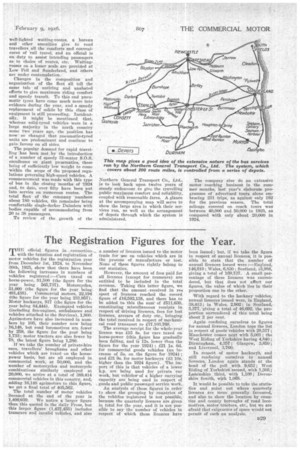The Registration Figures for the Year.
Page 13

If you've noticed an error in this article please click here to report it so we can fix it.
THE official figures in connection with the taxation and registration of motor vehicles for the registration year from December 1st, 1924, to November 30th, 1925, show that there have been the following increases in numbers of vehicles registered :—Cars taxed on horse-power, 91,500 (the figure for the year being 565,737). Motorcycles, 51,000 (the figure for the year being 491,438). Commercial motors, 22,194 the figure for the year being 231,957). Motor hackneys, 917 (the figure for the year being 84,444). Exempted vehicles (including fire-engines, ambulances and vehicles attached to the Services), 1,800. Agrimotors have also increased in numbers by 105, their number now being 16,148, bait road locomotives are fewer by 259, the figure for the year being 1,733; motor tractors are also fewer by 78, the latest figure being 1,280.
If we take the number of private-hire cars, travellers' broughams and other vehicles which are taxed on the horsepower basis, but are all employed in commercial work, at 50,000, and the number of motorcycles and motorcycle combinations similarly employed at 20,000, we arrive at a total of 389,414 commercial vehicles in this country, and, adding 16,148 agrimotors to this figure, we get a final total of 405,562.
The total number of motor vehicles licensed at the end of the year is 1,409;039. We notice a larger figure than this quoted in the daily Press, but this larger figure (1,437,455) includes tramcars and invalid vehicles, and also a number of lieenees issued to the motor trade for use on vehicles which are in the process of manufacture or test. None of these figures rightly belong to our statistics.
However, the amount of fees paid for all licences (except for tramcars) arc entitled to be included in the total revenue. Taking this latter figure, we find that the amount -received in resi spect of licences reached the record figure of 116,592,138, and there has to be added to this the sum of £511,630, constituting miscellaneous receipts in respect of driving licences, fees for lost licences, arrears of duty etc., bringing the total received in respect of mechanical road transport to 117,103,768.
The average receipt for the whole-year licence was 415 8s. for cars taxed on horse-power (this figure has gradually been falling. and is 12s. lower than the figure for the year 1924) ; 421 1s. 6d. for commercial goods vehicles (an increase of 5s. on the figure for 1924) ; and 431 9s. for motor hackneys (£3 10s, higher than the 1924 figure). The import of this is that vehicles of a lower h.p. are being used for private car work, but vehicles-of a higher carrying capacity are being used in respect of goods and public passenger service work.
An analysis of these figures in order ta show the grouping by countries of the vehicles registered is not possible, because the quarterly licences are given in total for the year, and it is not possible to say the number of vehicles in respect of which these licences have been issued ; but, if we take the figure in respect of annual licences, it is possible to state that the number of annual licences issued were :—England, 146,0.19; Wales, 6,830; Scotland, 15,988, giving a total of 169,737. A small percentage of these licences was surrendered, but that does not affect our figures, the value of which lies in their proportion one to the other.
With regard to the hackney vehicles, annual licences issued were, in England, 38,413; in Wales, 2902; in Scotland, 5,377, -giving a total of 46,692, the proportion surrendered of this total being about 2 per cent.
Again confining ourselves to figures for annual licences, London tops the list in respect of goods vehicles with 28,577; Manchester comes next with 5,001; the West Riding of Yorkshire having 4,840; Birmingham, 4.357: Glasgow, 3,850; and Liverpool, 3,760.
In respeet of motor hackneyS, and still confining ourselves to annual licences, London again stands at the head of the poll with 9,652; West Riding of Yorkshire second, with 1,305; Lancashire . third, with 1,109; Devonshire fourth, with 1,068.
It would be passible to take the statistics and point out -where quarterly licences are more generally favoured, and also to show the location by counties and county boroughs of road locomotives, motor tractors, etc., but we are afraid that exigencies of space would not permit of such an analysis.


























































